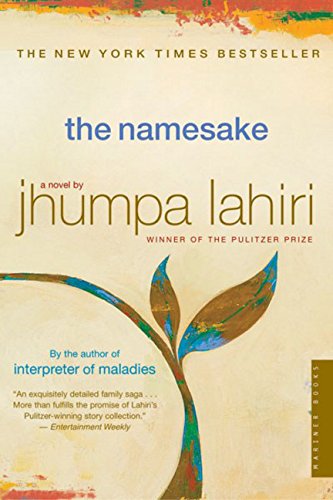
Reader: Blaga
Topic #5: Read a book by an immigrant or with a central immigration narrative
Book: The Namesake, by Jhumpa Lahiri
Publisher: Mariner Books (2004)
Originally Published by: Wheeler Publishing (2003)
Among the variety of topics that Jhumpa Lahiri addresses in her written work, immigration is among the most often addressed and one of the strongest. Her Pulitzer Prize-winning short-story collection The Interpreter of Maladies did so; her first novel, The Namesake, does as well. In it, Lahiri details the story of two generations of the Ganguli family: Gogol Ganguli, an American-born Indian architect, and his parents, Ashoke (an MIT-based scholar) and Ashima (a housewife), who immigrate to the United States at the beginning of the novel.
Lahiri tackles elements typical of immigrant experience: homesickness, the desire to belong, question of cultural identity, and inter-generational struggles. Being an immigrant myself, I have either witnessed or personally faced these, so any time I read a book that broaches the subject, I approach it with both curiosity and a fair degree of caution. Having read Lahiri’s short story collection beforehand, I knew I didn’t need to worry: this novel is full of familiar conflicts and relatable characters that bring the immigrant experience to life.
The key to the believable immigrant story that Lahiri tells is the changing viewpoints. Lahiri chose to narrate her novel from the perspectives of Ashima, Gogol, and, occasionally, Ashoke. Although Gogol’s perspective is the most prevalent, the interchange establishes a much fuller picture of the family’s unique dynamic. We readers get to see Ashima and Ashoke’s homesickness so that we can understand them far better, including why they are so stubbornly attached to their native culture, why almost all of their friends are Indian immigrants, and why they insist that their children experience their traditions. At the same time, we also come to understand why Gogol, a first generation American, rebels against his parents’ demands throughout his childhood and young adulthood, to the point where he even tries to abandon his own name.
Lahiri invites us to observe the slow evolution of the family and their personal identities. This evolution begins in the smallest things, as Ashima feels her life in Boston stabilize, as the family chooses to celebrate Thanksgiving and Christmas, and as the children adopt American lifestyles that even their parents can accept. Eventually, tragedy pushes the family to change much further and faster than ever before, and by the end of the novel, they find themselves in a strange middle ground common to American immigrant families, trapped between two cultures they both do and do not fully belong to. As Lahiri expresses it:
“And though [Ashima] still does not feel fully at home within these walls on Pemberton Road she knows that this is home nevertheless – the world for which she is responsible, which she created, which is everywhere around her…”
One other great asset of The Namesake is Lahiri’s writing itself: it is not simply the insightful handling of the subject matter, but the lyricism and pleasure of her prose. It flows – her sentences reflect her characters’ thoughts, carrying the reader along. Not once did I feel bored or want to skip ahead, which resulted in a more powerful and more immersive experience.
Ultimately, while Namesake is a book about immigration and immigrants, at its core it really is a story about family and about identity. Between the well-written characters and the beautiful prose, I highly recommend it.